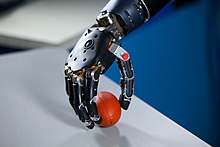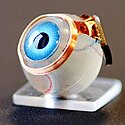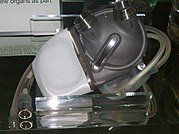An artificial organ is an engineered device or tissue that is implanted or integrated into a human — interfacing with living tissue — to replace a natural organ, to duplicate or augment a specific function or functions so the patient may return to a normal life as soon as possible. The replaced function does not have to be related to life support, but it often is. For example, replacement bones and joints, such as those found in hip replacements, could also be considered artificial organs.
Implied by definition, is that the device must not be continuously tethered to a stationary power supply or other stationary resources such as filters or chemical processing units. (Periodic rapid recharging of batteries, refilling of chemicals, and/or cleaning/replacing of filters would exclude a device from being called an artificial organ.) Thus, a dialysis machine, while a very successful and critically important life support device that almost completely replaces the duties of a kidney, is not an artificial organ.
Implied by definition, is that the device must not be continuously tethered to a stationary power supply or other stationary resources such as filters or chemical processing units. (Periodic rapid recharging of batteries, refilling of chemicals, and/or cleaning/replacing of filters would exclude a device from being called an artificial organ.) Thus, a dialysis machine, while a very successful and critically important life support device that almost completely replaces the duties of a kidney, is not an artificial organ.
Purpose
Constructing
and installing artificial organs, an extremely research-intensive and
expensive process initially, may entail many years of ongoing
maintenance services not needed by a natural organ.:
- providing life support to prevent imminent death while awaiting a transplant (e.g. artificial heart);
- dramatically improving the patient's ability for self care (e.g. artificial limb);
- improving the patient's ability to interact socially (e.g. cochlear implant); or
- improving a patient's quality of life through cosmetic restoration after cancer surgery or an accident.
The use of any artificial organ by humans is almost always preceded by extensive experiments with animals.
Initial testing in humans is frequently limited to those either already
facing death or who have exhausted every other treatment possibility.
Examples
Artificial limbs
A prosthetic arm
Artificial arms and legs, or prosthetics,
are intended to restore a degree of normal function to amputees.
Mechanical devices that allow amputees to walk again or continue to use
two hands have probably been in use since ancient times,
the most notable one being the simple peg leg. Since then, the
development of artificial limbs has progressed rapidly. New plastics and
other materials, such as carbon fiber
have allowed artificial limbs to become stronger and lighter, limiting
the amount of extra energy necessary to operate the limb. Additional
materials have allowed artificial limbs to look much more realistic. Prostheses can roughly be categorized as upper- and lower-extremity and can take many shapes and sizes.
New advances in artificial limbs include additional levels of
integration with the human body. Electrodes can be placed into nervous
tissue, and the body can be trained to control the prosthesis. This
technology has been used in both animals and humans. The prosthetic can be controlled by the brain using a direct implant or implant into various muscles.
Bladder
The two main methods for replacing bladder function involve either redirecting urine flow or replacing the bladder in situ. Standard methods for replacing the bladder involve fashioning a bladder-like pouch from intestinal tissue. As of 2017 methods to grow bladders using stem cells had been attempted in clinical research but this procedure was not part of medicine.
Brain
A diagram of a hippocampal prosthesis
Neural
prostheses are a series of devices that can substitute a motor, sensory
or cognitive modality that might have been damaged as a result of an
injury or a disease.
Neurostimulators, including deep brain stimulators, send electrical impulses to the brain in order to treat neurological and movement disorders, including Parkinson's disease, epilepsy, treatment resistant depression, and other conditions such as urinary incontinence. Rather than replacing existing neural networks
to restore function, these devices often serve by disrupting the output
of existing malfunctioning nerve centers to eliminate symptoms.
Scientists in 2013 created a mini brain that developed key
neurological components until the early gestational stages of fetal
maturation.
Corpora cavernosa
To treat erectile dysfunction, both corpora cavernosa can be irreversibly surgically replaced with manually inflatable penile implants. This is a drastic therapeutic surgery meant only for men who suffer from complete impotence
who have resisted all other treatment approaches. An implanted pump in
the (groin) or (scrotum) can be manipulated by hand to fill these
artificial cylinders, normally sized to be direct replacements for the
natural corpora cavernosa, from an implanted reservoir in order to
achieve an erection.
Testes
Men whom
have sustained testicular abnormalities through birth defects or injury
have been able to replace the damaged testicle with a testicular
prosthesis.
Although the prosthetic does not restore biological reproductive
function, the device has been shown to improve mental health for these
patients.
Ear
An illustration of a cochlear implant
In cases when a person is profoundly deaf or severely hard of hearing in both ears, a cochlear implant may be surgically implanted. Cochlear implants bypass most of the peripheral auditory system
to provide a sense of sound via a microphone and some electronics that
reside outside the skin, generally behind the ear. The external
components transmit a signal to an array of electrodes placed in the cochlea, which in turn stimulates the cochlear nerve.
In the case of an outer ear trauma, a craniofacial prosthesis may be necessary.
Eye
A bionic eye
The most successful function-replacing artificial eye so far is actually an external miniature digital camera with a remote unidirectional electronic interface implanted on the retina, optic nerve, or other related locations inside the brain.
The present state of the art yields only partial functionality, such as
recognizing levels of brightness, swatches of color, and/or basic
geometric shapes, proving the concept's potential.
Various researchers have demonstrated that the retina performs strategic image
preprocessing for the brain. The problem of creating a completely
functional artificial electronic eye is even more complex. Advances
towards tackling the complexity of the artificial connection to the
retina, optic nerve, or related brain areas, combined with ongoing
advances in computer science, are expected to dramatically improve the performance of this technology.
Heart
An artificial heart
Cardiovascular-related
artificial organs are implanted in cases where the heart, its valves,
or another part of the circulatory system is in disorder. The artificial heart is typically used to bridge the time to heart transplantation, or to permanently replace the heart in case heart transplantation is impossible. Artificial pacemakers
represent another cardiovascular device that can be implanted to either
intermittently augment (defibrillator mode), continuously augment, or
completely bypass the natural living cardiac pacemaker as needed. Ventricular assist devices
are another alternative, acting as mechanical circulatory devices that
partially or completely replace the function of a failing heart, without
the removal of the heart itself.
Besides these, lab-grown hearts and 3D bioprinted hearts are also being researched.
Currently, scientists are limited in their ability to grow and print
hearts due to difficulties in getting blood vessels and lab-made tissues
to function cohesively.
Kidney
It has been reported that scientists at the University of California, San Francisco, are developing an implantable artificial kidney.
As of 2018, these scientists have made significant advancements with
the technology but are still identifying methods to prevent the blood
clotting associated with their machine.
Liver
HepaLife is developing a bioartificial liver device intended for the treatment of liver failure using stem cells.
The artificial liver is designed to serve as a supportive device,
either allowing the liver to regenerate upon failure, or to bridge the
patient's liver functions until transplant is available.
It is only made possible by the fact that it uses real liver cells
(hepatocytes), and even then, it is not a permanent substitute.
Researchers from Japan found that a mixture of human liver precursor cells (differentiated from human induced pluripotent stem cells [iPSCs]) and two other cell types can spontaneously form three-dimensional structures dubbed “liver buds.”
Lungs
An artificial lung by MC3
With some almost fully functional, artificial lungs promise to be a great success in the near future. An Ann Arbor company MC3 is currently working on this type of medical device.
Extracorporeal membrane oxygenation
(ECMO) can be used to take significant load off of the native lung
tissue and heart. In ECMO, a one or more catheters are placed into the
patient and a pump is used to flow blood over hollow membrane fibers,
which exchange oxygen and carbon dioxide with the blood. Similar to
ECMO, Extracorporeal CO2 Removal (ECCO2R) has a similar set-up, but
mainly benefits the patient through carbon dioxide removal, rather than
oxygenation, with the goal of allowing the lungs to relax and heal.
Ovaries
The ground work for the development of the artificial ovary was laid in the early 1990s.
Reproductive age patients who develop cancer often receive
chemotherapy or radiation therapy, which damages oocytes and leads to
early menopause. An artificial human ovary has been developed at Brown
University
with self-assembled microtissues created using novel 3-D petri dish
technology. In a study funded and conducted by the NIH in 2017,
scientists were successful in printing 3-D ovaries and implanting them
in sterile mice. In the future, scientists hope to replicate this in larger animals as well as humans.
The artificial ovary will be used for the purpose of in vitro
maturation of immature oocytes and the development of a system to study
the effect of environmental toxins on folliculogenesis.
Pancreas
An artificial pancreas is used to substitute endocrine functionality of a healthy pancreas
for diabetic and other patients who require it. It can be used to
improve insulin replacement therapy until glycemic control is
practically normal as evident by the avoidance of the complications of hyperglycemia, and it can also ease the burden of therapy for the insulin-dependent. Approaches include using an insulin pump under closed loop control, developing a bio-artificial pancreas consisting of a biocompatible sheet of encapsulated beta cells, or using gene therapy.
Thymus
An
implantable machine that performs the function of a thymus does not
exist. However, researchers have been able to grow a thymus from
reprogrammed fibroblasts. They expressed hope that the approach could
one day replace or supplement neonatal thymus transplantation.
As of 2017, researchers at UCLA developed an artificial thymus
that, although not yet implantable, is capable of performing all
functions of a true thymus.
Trachea
The field of artificial tracheas went through a period of high interest and excitement with the work of Paolo Macchiarini at the Karolinska Institute
and elsewhere from 2008 to around 2014, with front-page coverage in
newspapers and on television. Concerns were raised about his work in
2014 and by 2016 he had been fired and high level management at
Karolinska had been dismissed, including people involved in the Nobel Prize.
As of 2017 engineering a trachea—a hollow tube lined with
cells—had proved more challenging then originally thought; challenges
include the difficult clinical situation of people who present as
clinical candidates, who generally have been through multiple procedures
already; creating an implant that can become fully developed and
integrate with host while withstanding respiratory forces, as well as
the rotational and longitudinal movement the trachea undergoes.
Enhancement
It is also possible to construct and install an artificial organ to
give its possessor abilities that are not naturally occurring. Research
is proceeding in areas of vision, memory, and information processing. Some current research focuses on restoring short-term memory in accident victims and long-term memory in dementia patients.
One area of success was achieved when Kevin Warwick carried out a series of experiments extending his nervous system
over the internet to control a robotic hand and the first direct
electronic communication between the nervous systems of two humans.
This might also include the existing practice of implanting subcutaneous chips for identification and location purposes (ex. RFID tags).
Microchips
Organ chips are devices containing hollow microvessels filled with
cells simulating tissue and/or organs as a microfluidic system that can
provide key chemical and electrical signal information.
This information can create various applications such as creating "human in vitro models" for both healthy and diseased organs, drug advancements in toxicity screening as well as replacing animal testing.
Using 3D cell culture techniques enables scientists to recreate the complex extracellular matrix, ECM, found in in vivo to mimic human response to drugs and human diseases.
Organs on chips are used to reduce the failure rate in new drug
development; microengineering these allows for a microenvironment to be
modeled as an organ.






